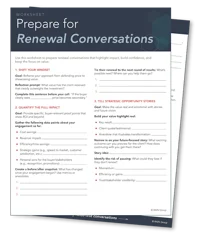If you’re heading into renewal conversations thinking the biggest hurdle is pricing, you’re not alone. But here’s what you need to know: price resistance is rarely the real issue.
What actually derails renewals is when buyers don’t fully recognize the value you’ve delivered or what’s still ahead. When they clearly see value outweighs cost, price objections fade.
Here’s a five-part playbook to help you lead confident, value-first renewal conversations that inspire buyers to keep investing and even grow the partnership.
Think Value Over Price in Renewal Conversations
- Shift Your Mindset: Stop Defending Price, Start Showcasing Value
- Quantify the Full Impact (Not Just ROI)
- Tell Strategic Opportunity Stories
- Multi-Thread the Renewal
- Negotiate with Confidence and Control
Worksheet: Prepare for Renewal Conversations
Download this complimentary worksheet to prepare renewal conversations that highlight value and impact.
1. Shift Your Mindset: Stop Defending Price, Start Showcasing Value
On their face, renewal discussions appear to be all about justifying a price increase. But really, these discussions are an opportunity to go beyond highlighting the results you’ve already helped deliver to framing what’s next.
When you believe in the value your client gets from working with you, and can clearly articulate it, you project confidence and substantiate why they should continue buying from you. Before diving into decks or prep calls, ground yourself in this mindset:
“If my clients clearly see a mountain of value, price becomes secondary.”
Let this guide every renewal conversation. You’re not defending a fee; you’re leading a value conversation.
Free Download: Your Guide to Value-Based Selling in Complex Sales >>
2. Quantify the Full Impact (Not Just ROI)
ROI matters, but clients measure value in broader terms. Beyond financial return, they weigh factors such as revenue growth, risk reduction, operational efficiency, competitive advantage, and even personal wins like promotions or recognition.
Use RAIN Group’s value-based selling tools to:
- Look beyond surface metrics: Think cost savings, speed to results, strategic positioning.
- Illustrate the before-and-after: Show the transformation from pre-engagement to today, then frame the renewal as the springboard for the next wave of results.
Tip: Bring a simple visual to make the transition tangible. The Buyer Change Blueprint helps you map the current state, desired future state, and the path to get there so the renewal reads as the next step in a larger value journey.
- Link investment to future gains: Present the renewal fee as the key that unlocks the next wave of results, not payment for past services.
Come to the table with client-specific numbers and examples. A clear, compelling value model turns a price increase into a logical or even exciting investment.
3. Tell Strategic Opportunity Stories
Data makes the case, but stories make it stick. Strengthen your renewal message by crafting narratives that paint a vivid picture of success—past and future.
Try this storytelling approach:
- Create a “Value Highlight Reel:” Curate a few proof points that resonate emotionally and commercially, including standout results, powerful client quotes, or breakthrough wins that exceeded expectations.
- Preview what’s next: Use convincing stories to help the client see the next round of wins they’ll unlock by continuing with you.
- Highlight what’s at risk: Subtly show what they might lose if they pause, such as momentum, efficiency, stakeholder trust, or market position.
When clients connect emotionally to the progress they’ve achieved—and clearly envision what lies ahead—the renewal decision becomes not just logical, but compelling.
4. Multi-Thread the Renewal
Even when your core contact sees the value, renewals can stall if other decision makers aren’t convinced. In complex sales, it’s rarely a single-threaded decision—multiple stakeholders weigh in and each looks for different proof points.
To prepare:
- Map the Buying Committee: Identify champions, approvers, evaluators, and influencers who shape the decision.
- Tailor Value to Each Role: Speak to what matters most for each stakeholder, whether it’s risk reduction for finance, efficiency gains for operations, or momentum for executives.
- Equip Your Champion: Arm your internal advocate with stories, metrics, and responses to common pushbacks so they can carry the value case forward.
- Highlight Continuity Risk: Make clear what’s at stake for each role if the partnership pauses, such as lost momentum, exposure to risk, or declining efficiency.
When every stakeholder sees their version of the value story, alignment accelerates and the renewal becomes the obvious choice.
5. Negotiate with Confidence and Control
Even when value is clear, renewal conversations can derail without a plan. Arrive with a strategy that keeps the discussion value-led and goal-focused. Use these tactics:
- Know your BATNA (best alternative to a negotiated agreement): Be clear on your walk-away point so you don’t concede reactively.
- Lead with outcomes, not price: Frame the conversation around what continuing unlocks before ever discussing cost.
- Offer strategic concessions. Prepare low-cost, high-value add-ons that create goodwill without cutting into margin, such as an executive workshop, additional training, or an accelerated rollout.
The more you anchor negotiations in preparation and outcomes, the more confident and credible you’ll appear, and the more likely you’ll secure a renewal.
Download Now: Mastering Sales Negotiations Toolkit >>
Leading Value-First Conversations
Renewal conversations are your chance to reinforce value, deepen relationships, and align decision makers around what comes next. By shifting your mindset, quantifying impact, telling compelling stories, multi-threading across stakeholders, and negotiating with confidence, you lead value-first discussions that keep momentum strong and position the renewal as the clear next step in your partnership.
Make a strong value case in your renewal conversations with this complimentary worksheet.









